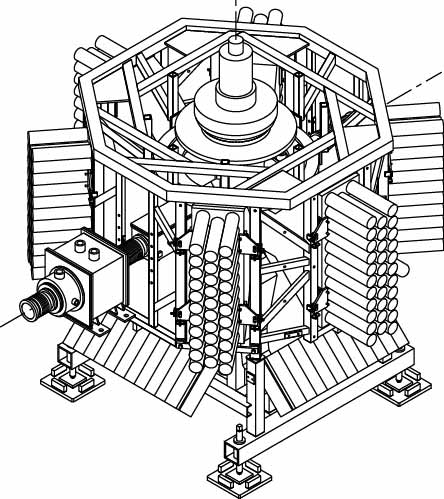
SXD-11
A NEW INSTRUMENT FOR TIME-OF-FLIGHT NEUTRON DIFFRACTION
|
|
I was responsible for a three-year EPSRC-funded project to build a new single crystal diffractometer at ISIS (GR/M52243). The project began in November 1999 and since May 2001 the full complement of detectors and sample supporting assembly have been installed and fully operational. The instrument is located on beamline S3, the site of the previous SXD diffractometer and it consists of eleven position-sensitive detectors surrounding the sample in and below the equatorial plane on the instrument and covering 2p solid angle. The detectors have 64x64 pixels, each a square of dimensions 3x3mm2, and they consist of a single sheet of zinc sulphide scintillator fibre-optically coupled to photo-multiplier tubes. They are based on the existing SXD detector design which was developed at ISIS.
The principle behind the instrument is to maximise the solid angle coverage of the detectors to minimise the number of crystal rotations required to complete a single crystal data-set. This is further helped on SXD-11 since it uses the polychromatic pulsed beam from ISIS to collect data as a function of neutron wavelength as well as angle. As a result only a small number of crystal rotations about a single axis are required.
The major advantage of this approach is that the speed of data collection may be significantly improved. It is now possible to collect data from more complex structures or from physically smaller samples in the same, or shorter, time than previously required for more standard neutron sized samples. Another advantage is that with the quasi-fixed sample it is possible to envisage more complex sample environments ands much work using helium gas high-pressure cells has already been carried out on the diffractometer.
The project ended in November 2002 with the completion of various beamline components (beam-defining jaws, laser sample alignment and further shielding) and some additional sample environment equipment. On completion of the project the name of the instrument has returned to ... SXD. The descriptive part of the EPSRC final grant report can be found here.
Details of the instrument are available on the ISIS web pages, together with information about how to apply for time to carry out experiments on SXD. The instrument scientist for SXD is now Matthias Gutmann; he should be contacted for up to date further information about SXD.
|
|